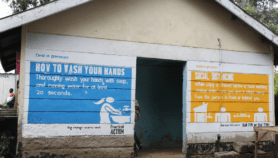Send to a friend
The details you provide on this page will not be used to send unsolicited email, and will not be sold to a 3rd party. See privacy policy.
[ACEH/COLOMBO/NEW DELHI] Tsunami warning systems appear to have worked effectively during last week’s (11 April) earthquake and aftershocks off the Indonesian coast of Sumatra, but experts say improvements are still needed.
The 8.6 magnitude undersea quake triggered a tsunami warning in several countries. It was the first real-time test of three tsunami warning systems — in Australia, India and Indonesia — which were all developed following the 2004 Asian tsunami, which killed nearly a quarter of a million people.
Reuters reported that the regional system had "passed a major test" on 11 April, but some residents in Banda Aceh told SciDev.Net they heard no warning and only ran to safety because they felt the ground shaking, despite the Geophysics and Climate Bureau issuing a tsunami warning at 3.38pm local time.
"I did not hear anything, no siren whatsoever. I just felt the earth was moving hard so I ran to a safe place. Nobody told me where to go and how to act," local resident Muhajir told reporters.
Despite the magnitude of the initial quake and subsequent aftershocks, no major tsunami was triggered, as the earth’s crust moved horizontally rather than vertically. Vertical tectonic plate movement displaces water upwards, and can trigger massive columns of waves — as was the case in 2004.
As a result, the speed at which scientists can identify the direction in which the earth’s crust has moved in the event of an earthquake is crucial in issuing an accurate tsunami forecast quickly, according to Shailesh Nayak, secretary of India’s ministry of earth sciences.
Currently it takes up to an hour-and-a-half to receive this information, he told SciDev.Net. "This is not sufficient. We should get this information within five or six minutes," he said.
Agung Laksono, Indonesia’s coordinating minister for people’s welfare, admitted that "of six sirens installed in Aceh waters, only two are working".
In Thailand, some sirens also reportedly failed to function due to poor maintenance. Many hotels have installed their own sirens to warn people to move to higher ground.
Disseminating information about a tsunami warning also needs attention, experts say. In Sri Lanka, a warning is only issued for the highest level of tsunami threat, in which immediate evacuation is required. Some have called for that policy to be changed.
"We need to classify the level of threat … that is, tsunami watch (for example, green, keep listening to radio/tv for further info), alert (amber, keep away from the beach) and warning (red, immediately evacuate to higher ground)," said Janaka Wijetunga, a senior lecturer at the department of civil engineering at Sri Lanka’s University of Peradeniya, who added that such a system is already in place in India.
If current policy was changed, public education would be also needed to ensure residents understand varying threat levels, he said.
Other targets for improvement, according to Nayak, include computer simulation models and better software to process large volumes of data quickly. The number of data-gathering stations needs to be expanded, he said.
He added that existing systems also need to incorporate more data on ocean water depths using under-water sounders or sensors, and from ‘topographic’ sites — such as ground elevation — to improve computer simulation studies and provide better inundation predictions.
Nayak said some countries lack the capacity to gather such data, while others are reluctant to part with information due to security concerns.
"We [India] have collected what we need for our computer simulation models. But the same model can’t be run equally effective in [the] Maldives or Seychelles, for example, without specific inputs from [the] territorial waters of these places," he said.
Additional reporting by T. V. Padma and Pratchaya W.













